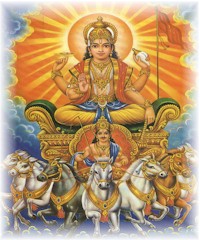| ||
| Then an offering of “khir” made of wheat is shown to the sun. In the “sup” (basket for sifting corn) twelve heaps of grain are offered to the sun, the number corresponding to the twelve constellations through which the sun goes. Grain is offered to the brahmins.Some people show their respect to the sun by bowing twelve times every day to the sun, repeating every time one of the twelve names of the sun. These twelve names are: Mitra, Ravi, Surya, Ahanu, Khag, Pushan, Hirnyagarbha, Marichi, Aditya, Savita, Arka, and Bhaskar. On this day a new season begins, the sun sitting on his chariot sets out on his journey. | ||
| In the country of Kamboj there was a king named Yashovarma. He was a religious minded ruler, arid happiness prevailed in his kingdom. But the king had become old and had no children. He prayed to God to give him a son. Finally God heard his prayer and the king got a son. But the son was very sickly. All remedies were tried but the boy would not be cured. | ||
| One day a Muni named Vinit came to the palace. He was a very learned Muni and knew the three times (“tricalgnani”), which means that he knew the past, the present, and the future. So the king asked the Muni when his son would get alright. Muni Vinit remained with his eyes closed for a while. Then he said to the king, “Your son is sick because in his previous life he was very rich, but never gave any alms and used his wealth for himself only.” | ||
| King Yashovarma asked, “If he was a sinner, how is it that he was born the son of a king?” Muni Vinit replied, “Yes, he was a sinner in his previous life. But once with his eyes he saw the “puja” (worship) of Rath Saptami. With this he acquired the merit needed to be born of a royal family.” “So, will not his sickness disappear by a similar act of merit?” King Yashovarma eagerly asked. “Yes, make him observe the vow of ‘Rath Saptami’ and his sickness will completely disappear.” Then Mimi Vinit gave the king information about Rath Saptami and by the merit of this vow the King’s son was liberated from his disease. | ||
| The Gayatri Mantra From ancient times men have attributed divinity to the sun. For the “munj” (thread) ceremony the boy is made to stand facing the sun, and the priest makes the following prayer, “Oh Sun, this is your student. Protect him, and give him a long life.” After the “munj” ceremony every day in the evening the Gayatri mantra must be recited. This mantra is given great importance: “God is the mover of this world. The shining brilliance of God is the most exalted and the most difficult to describe. This brilliance is liked by everybody. We meditate upon such brilliance. We bring it to our mind. May this God, who is the sun, inspire our intellect and our devotional medita-tion and may the recitation of this gayatri illumine our intellect.” |
Suya Namskar are done to on this occasion
:
Surya Namaskara (IAST: Sūrya namaskāra) or Sun Salutation (lit. "salute to the sun"), is a common sequence of Hatha yoga asanas. Its origins lie in a worship of Surya, the Hindu solar deity. This sequence of movements and poses can be practised on varying levels of awareness, ranging from that of physical exercise in various styles, to a complete sadhana which incorporates asana, pranayama, mantra and chakra meditation.
The physical base of the practice links together twelve asanas in a dynamically performed series. These asanas are ordered so that they alternately stretch the spine backwards and forwards. When performed in the usual way, each asana is moved into with alternate inhalation and exhalation (except for the sixth asana where the breath is held in external suspension). A full round of Surya namaskara is considered to be two sets of the twelve poses with a change in the second set to moving the opposite leg first through the series.
Proponents of the use of Surya namaskara as part of the modern yoga tradition prefer to perform it at sunrise, which the orthodox consider to be the most 'spiritually favourable' time of the day.



No comments:
Post a Comment